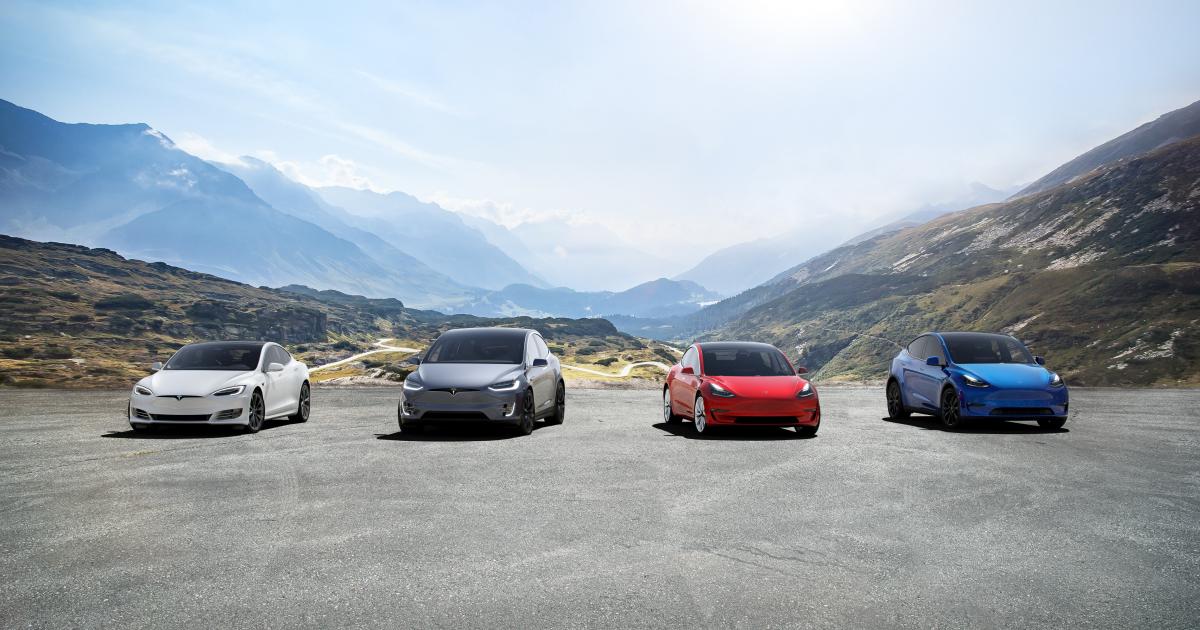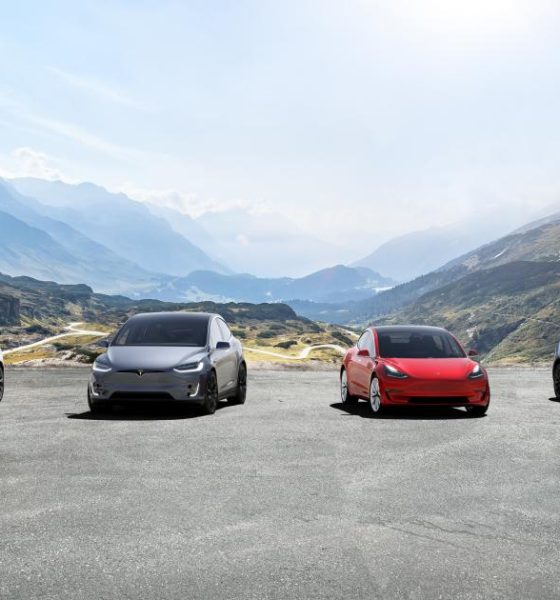Out of every 10 electric cars registered in the United States in 2020, nearly eight of them were built by Tesla.
New data from Automotive News shows that Tesla owned 79% of the total EVs registered in the U.S. in 2020, leaving only 21% for the other manufacturers to divide up between themselves. This overwhelming domination is also followed by somewhat obvious premonition: Tesla’s four currently-offered electric cars made up four of the top five spots. With the Chevy Bolt EV taking third, the Model 3, Model Y, Model X, and Model S took first, second, fourth, and fifth place, respectively.
Tesla’s Domination of the U.S. EV Sector
It is no secret Tesla has dominated the EV sector across the world. With its industry-leading software, battery tech, and performance specifications, if someone is going to buy an electric car, it should be a Tesla most of the time. U.S. consumers agree with this statement, especially after nearly 80% of all EVs in the United States in 2020 were built by the Elon Musk-headed company. Tesla’s dominant charge was led by the Model 3, as it was registered 95,135 times in 2020, according to the data. The Model Y came in second with 71,344, the Model X in fourth with 19,652, and the Model S in fifth with 14,430.
It is no surprise the Model 3 and Model Y, Tesla’s two most affordable cars, dominated the table. The third-place Chevy Bolt EV trailed the second-place Model Y by 51,680 units, making it a head-and-shoulders lead by the two Tesla vehicles.
ALSO READ:
Tesla registrations in California in Q4 jump as Model Y shines in home state
The Model Y and Model 3 are comparable with the same overall look and interior design, one is just slightly more prominent as the Y is a crossover. The Model 3 sedan is no joke either, mainly because it is the most popular EV globally. Its affordability, versatility, and three offered variants make it the ideal choice for basically anyone who has any desire. Whether it’s a daily driver or something to take on speedy weekend drives, the Model 3 fits the bill for nearly anyone.
Growth filed in by manufacturing
Tesla saw a 16% increase in vehicle registrations in 2020 compared to 2019. With more cars being offered, it is no surprise that there is some growth in terms of the U.S. market. The Model Y finally gave Tesla the chance to compete in a highly-competitive crossover SUV market. With more people under the impression that electric powertrains are the way to go, Tesla shouldn’t see any declines for the foreseeable future. However, the company will have to deal with increased demand through a series of production plant projects. One of which is already underway in Austin, as Giga Texas nears its first production runs scheduled for this Summer.
Elon Musk has plans to open a third production facility sometime within the next few years. In an interview with Automotive News in 2020, the Tesla CEO indicated that the next U.S.-based facility would be operating in the Northeast region of the United States. This would effectively allow all three plants to control the United States in thirds: Fremont would take care of S and X production as a whole, but 3 and Y builds would stay in the Western-third of the country. Giga Texas will control the center of the U.S., and the unannounced third U.S. Gigafactory would take care of owners and orderers in the Eastern third of the country.
Musk said:
“I think at some point, there will be a third Gigafactory [in the U.S.]. I’d imagine, you know, closer up North, Northeast, most likely.”
Production efficiencies have also been a major point of focus for Tesla as manufacturing has been an issue that Musk intends to improve upon constantly. The company has made several moves toward automation and has used things like the Giga Press to improve manufacturing efficiency. It eliminated 69 total parts from the Model Y’s rear casting, increasing quality while decreasing the time spent to build a single cast. Eventually, Musk says the Model 3 will also use a single-piece casting.
Tesla will have its work cut out for it within the next several years. With new manufacturers like Rivian and Lucid joining the EV sector this year, Tesla will have its first batch of all-electric competition in the U.S.

News
Nvidia CEO Jensen Huang explains difference between Tesla FSD and Alpamayo
“Tesla’s FSD stack is completely world-class,” the Nvidia CEO said.

NVIDIA CEO Jensen Huang has offered high praise for Tesla’s Full Self-Driving (FSD) system during a Q&A at CES 2026, calling it “world-class” and “state-of-the-art” in design, training, and performance.
More importantly, he also shared some insights about the key differences between FSD and Nvidia’s recently announced Alpamayo system.
Jensen Huang’s praise for Tesla FSD
Nvidia made headlines at CES following its announcement of Alpamayo, which uses artificial intelligence to accelerate the development of autonomous driving solutions. Due to its focus on AI, many started speculating that Alpamayo would be a direct rival to FSD. This was somewhat addressed by Elon Musk, who predicted that “they will find that it’s easy to get to 99% and then super hard to solve the long tail of the distribution.”
During his Q&A, Nvidia CEO Jensen Huang was asked about the difference between FSD and Alpamayo. His response was extensive:
“Tesla’s FSD stack is completely world-class. They’ve been working on it for quite some time. It’s world-class not only in the number of miles it’s accumulated, but in the way it’s designed, the way they do training, data collection, curation, synthetic data generation, and all of their simulation technologies.
“Of course, the latest generation is end-to-end Full Self-Driving—meaning it’s one large model trained end to end. And so… Elon’s AD system is, in every way, 100% state-of-the-art. I’m really quite impressed by the technology. I have it, and I drive it in our house, and it works incredibly well,” the Nvidia CEO said.
Nvidia’s platform approach vs Tesla’s integration
Huang also stated that Nvidia’s Alpamayo system was built around a fundamentally different philosophy from Tesla’s. Rather than developing self-driving cars itself, Nvidia supplies the full autonomous technology stack for other companies to use.
“Nvidia doesn’t build self-driving cars. We build the full stack so others can,” Huang said, explaining that Nvidia provides separate systems for training, simulation, and in-vehicle computing, all supported by shared software.
He added that customers can adopt as much or as little of the platform as they need, noting that Nvidia works across the industry, including with Tesla on training systems and companies like Waymo, XPeng, and Nuro on vehicle computing.
“So our system is really quite pervasive because we’re a technology platform provider. That’s the primary difference. There’s no question in our mind that, of the billion cars on the road today, in another 10 years’ time, hundreds of millions of them will have great autonomous capability. This is likely one of the largest, fastest-growing technology industries over the next decade.”
He also emphasized Nvidia’s open approach, saying the company open-sources its models and helps partners train their own systems. “We’re not a self-driving car company. We’re enabling the autonomous industry,” Huang said.
Elon Musk
Elon Musk confirms xAI’s purchase of five 380 MW natural gas turbines
The deal, which was confirmed by Musk on X, highlights xAI’s effort to aggressively scale its operations.

xAI, Elon Musk’s artificial intelligence startup, has purchased five additional 380 MW natural gas turbines from South Korea’s Doosan Enerbility to power its growing supercomputer clusters.
The deal, which was confirmed by Musk on X, highlights xAI’s effort to aggressively scale its operations.
xAI’s turbine deal details
News of xAI’s new turbines was shared on social media platform X, with user @SemiAnalysis_ stating that the turbines were produced by South Korea’s Doosan Enerbility. As noted in an Asian Business Daily report, Doosan Enerbility announced last October that it signed a contract to supply two 380 MW gas turbines for a major U.S. tech company. Doosan later noted in December that it secured an order for three more 380 MW gas turbines.
As per the X user, the gas turbines would power an additional 600,000+ GB200 NVL72 equivalent size cluster. This should make xAI’s facilities among the largest in the world. In a reply, Elon Musk confirmed that xAI did purchase the turbines. “True,” Musk wrote in a post on X.
xAI’s ambitions
Recent reports have indicated that xAI closed an upsized $20 billion Series E funding round, exceeding the initial $15 billion target to fuel rapid infrastructure scaling and AI product development. The funding, as per the AI startup, “will accelerate our world-leading infrastructure buildout, enable the rapid development and deployment of transformative AI products.”
The company also teased the rollout of its upcoming frontier AI model. “Looking ahead, Grok 5 is currently in training, and we are focused on launching innovative new consumer and enterprise products that harness the power of Grok, Colossus, and 𝕏 to transform how we live, work, and play,” xAI wrote in a post on its website.
Elon Musk
Elon Musk’s xAI closes upsized $20B Series E funding round
xAI announced the investment round in a post on its official website.

xAI has closed an upsized $20 billion Series E funding round, exceeding the initial $15 billion target to fuel rapid infrastructure scaling and AI product development.
xAI announced the investment round in a post on its official website.
A $20 billion Series E round
As noted by the artificial intelligence startup in its post, the Series E funding round attracted a diverse group of investors, including Valor Equity Partners, Stepstone Group, Fidelity Management & Research Company, Qatar Investment Authority, MGX, and Baron Capital Group, among others.
Strategic partners NVIDIA and Cisco Investments also continued support for building the world’s largest GPU clusters.
As xAI stated, “This financing will accelerate our world-leading infrastructure buildout, enable the rapid development and deployment of transformative AI products reaching billions of users, and fuel groundbreaking research advancing xAI’s core mission: Understanding the Universe.”
xAI’s core mission
Th Series E funding builds on xAI’s previous rounds, powering Grok advancements and massive compute expansions like the Memphis supercluster. The upsized demand reflects growing recognition of xAI’s potential in frontier AI.
xAI also highlighted several of its breakthroughs in 2025, from the buildout of Colossus I and II, which ended with over 1 million H100 GPU equivalents, and the rollout of the Grok 4 Series, Grok Voice, and Grok Imagine, among others. The company also confirmed that work is already underway to train the flagship large language model’s next iteration, Grok 5.
“Looking ahead, Grok 5 is currently in training, and we are focused on launching innovative new consumer and enterprise products that harness the power of Grok, Colossus, and 𝕏 to transform how we live, work, and play,” xAI wrote.










